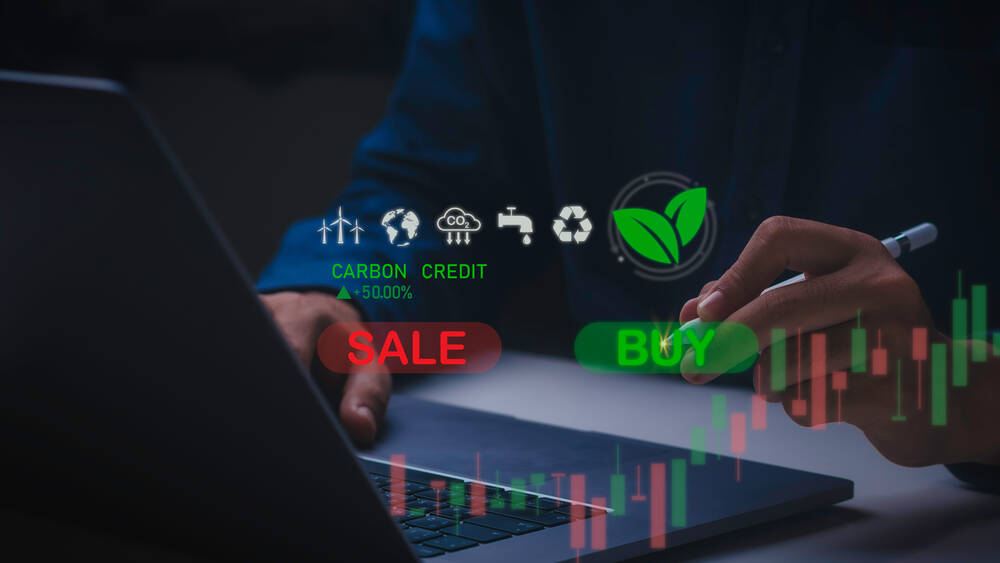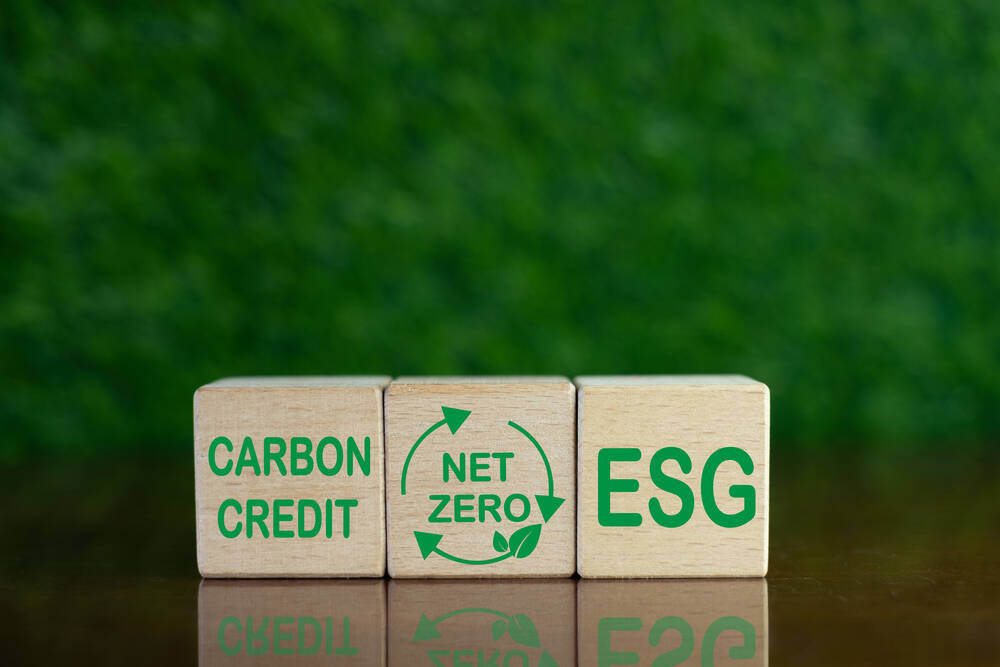Key Takeaways:
- When buying carbon credits, you’re actively funding nature-positive projects from around the world.
- The projects you buy should use verified standards (e.g. Verra), as fake and double-counted credits do exist.
- Different credit types serve different needs to suit a vast range of company types and sustainability targets.
Buying carbon credits allows you to develop a new project in a way that reduces emissions and drives meaningful emission reductions. Projects vary from biochar production to funding off-shore wind farms, with 3 predominant types.
With thousands of certified carbon initiatives around the world, project developers can support the planet and protect the biodiverse environment through buying carbon credits that offset their emissions.
Whether aiming for net zero by 2030 or just wanting to attract the right stakeholders from your ESG strategies, today’s circulation of carbon credits offers diverse opportunities to drive significant change and future-proof your business for upcoming years sustainably.
What Are Carbon Credits For?
A carbon credit represents the right to emit one metric ton of CO₂ equivalent (CO₂e).
Essentially, one carbon credit equates to one tonne of carbon dioxide (CO₂) or its equivalent in other GHG emissions. Carbon credits represent a decrease in GHG emissions that can be bought and sold on carbon markets.
These credits are a key tool in the fight against climate change. As the world continues to face the consequences of global warming, it is becoming increasingly important for countries and organisations to reduce their carbon footprint.
Carbon credits provide a way for organisations to offset their emissions and contribute to a more sustainable future.
Why Buy Carbon Credits?
Carbon credits play a key role in offsetting emissions that are unavoidable, such as long-distance transportation or industrial processes.
They enable the funding of carbon reduction and removal projects, such as renewable energy installations, reforestation, and soil carbon sequestration.
By promoting innovative, nature-based solutions, ecosystems and biodiversity are duly protected.
The Gaia Marketplace is expanding its natural asset classes to include carbon credits, offering a new avenue for businesses to achieve their net zero goals.
Are Carbon Credits Worth It?

Businesses have a critical responsibility to acknowledge and address their carbon emissions.
Carbon credits can help prevent green-washing and other misleading environmental claims. A dutiful, responsible brand image is maintained when a company accurately offsets their emissions.
Sustainable business is more efficient and can lead to financial benefits. This brings in whole new revenue streams from environmentally conscious customers, as carbon credits can ultimately make a business more competitive.
Using carbon credits strategically strengthens investor relationships, encouraging support. Investors are significantly more inclined to accord funding to forward-thinking organisations.
One of the most integral benefits of using carbon credits is future-readiness, as carbon regulations will only become tighter in the future.
Types of Carbon Credits
There are a broad range of carbon credits from algae-farms to biologically-encaptured charcoal. The main types are:
- Nature-based credits: Restoring or re-creating carbon sequestering habitats allows more CO₂ to be absorbed into nature long-term; buying the carbon credits usually funds the investment of this work.
- Removal credits: These take CO₂ that has already been let into the atmosphere, such as reforestation (growing trees to absorb carbon) or BECCS (using bioenergy to take in emissions at strategic locations).
- Reduction credits: These reduce the amount of emissions that are already being emitted in ongoing activities, like optimising a building’s heating and cooling systems.
- Avoidance credits: Buying these credits means investing into products that will hugely prevent emissions in the long-term, i.e. wind farms.
Avoidance Credits
Avoidance credits are given for projects preventing future emissions of greenhouse gases (such as renewable energy projects and forest conservation).
These credits do not physically remove CO₂ from the atmosphere but rather prevent further emissions.
Reduction Credits
On the other hand, reduction credits directly move or reduce greenhouse gas emissions that are currently ongoing.
Think energy efficiency projects, reducing the amount of CO₂ emitted by buildings, or reforestation, lowering atmospheric carbon due to absorption.
Removal Credits
Removal credits involve removing carbon that has already gone into the atmosphere.
This can look like reforestation; planting trees in areas that have been deforested, giving the forest a chance to take over again. This can be government-led or community driven, and allows for the long-term production of resources while enhancing biodiversity.
Afforestation, on the other hand, is the planting of trees in non-forested areas, creating new ecosystems that can convert degraded land, such as brownfield sites, into productive biodiversity hotspots.
Nature-Based Credits
Forest conservation is one of the most significant types of carbon credits, protecting natural carbon sinks while reducing emissions from deforestation and forest degradation. REDD+ stands for Reducing Emissions from Deforestation and Forest Degradation.
Wetlands and mangroves can store masses of carbon in both soil and biomass.
Not only critical for biodiversity, essential ecosystems, and services humans rely on for just about all parts of life, their restoration makes for popular nature-based carbon credits.
Blue carbon credits involve the conservation and restoration of critical marine habitats, in high demand of companies supporting marine biodiversity while offsetting emissions. For instance, seagrass meadows can store carbon up to 35 times faster than tropical forests, and the carbon stored is trapped under sediment, locked for 1,000 years.
Technology-Based Credits
A strong example of tech-based carbon credits are Direct Air Capture and Storage (DACS) credits.
This involves large-scale systems to extract CO₂ from ambient air and inject it deep underground, permanently trapped in reservoirs. Misconceived to be placed near sources of high CO₂ emissions (which is CCS), DACS technology is actually designed to capture diffuse atmospheric CO₂, making location near concentrated emitters unnecessary.
For each verified ton of CO₂ removed through DAC, a carbon credit can be sold or traded.
Voluntary vs. Compliance Markets
Carbon markets are digital trading platforms operating similarly to stock exchanges, used by any company with a carbon footprint.
The two main types are voluntary markets (involving the buy and sell of carbon credits on independently regulated, privately-owned platforms) and compliance markets (involving cap-and-trade systems; governmentally regulated and owned).
In voluntary markets, credits involve purchasing the equivalent amount of emissions to offset the company’s footprint. This usually covers unavoidable emissions, like sporadic Scope 3 emissions such as business travel, supply chain logistics, or outsourced manufacturing.
In compliance markets, allowances are allocated based on government-set caps, sometimes auctioned to businesses based on their industry or historical emissions. The companies can either stay under this limit or exceed it but then must purchase allowances to compensate.
If a company buys excess allowances, such as because of unexpected operational cuts or efficiency upgrades, they can sell it by trading on regulated exchanges or at auctions to other companies needing allowances.
How Do You Buy Carbon Credits?

It’s a relatively straightforward process to purchase carbon credits, but you need to know the steps in place and the correct order.
Platforms like Gaia streamline the process for you by ensuring all providers are credible, showcasing their verified standards, enabling a straightforward transaction process and offering the steps for proper credit retirement.
The following steps are a strong approach to adopt when purchasing carbon credits.
Step 1: Choose a Reputable Provider
To buy carbon credits, the first step is to identify your provider: a platform, organisation, or broker selling carbon credits.
Some create the projects themself, or others (like Gaia) run platforms selling projects from a range of trusted providers through a marketplace or website.
Like ours, these platforms ensure all projects are real, verified through trusted standards like the UK Woodland Carbon Code, and fully retired once sold.
Step 2: Understand the Project Type
After choosing your provider, you must then understand the various types of carbon projects available and which best fit your sustainability objectives.
For instance, if aiming for net zero, you’d likely go for a removal-type project; helpful for offsetting unavoidable emissions when achieving carbon neutrality.
If you’re only reducing overall emissions, reduction or avoidance-type projects could surely suffice.
Step 3: Verify Certification Standards
When you know what project types you’ll be purchasing, you must be sure to verify them.
All credible carbon credits should have an adjoining verifier, such as Verra, Gold Standard, or Woodland Carbon Code for UK forestry projects.
These may be listed on public registries or verified by an independent body, and if they aren’t, you can’t trust that the carbon will be permanently offset.
Step 4: Decide How Many Credits to Buy
It’s best practice to either use carbon accounting software to attain a full picture of carbon emissions, or at least a carbon calculator, to gauge a specific footprint of a set product, project, organisation or business.
This usually follows the GHG Protocol’s 3 scopes of direct, indirect, and supply chain emissions.
One carbon credit equates to one tonne of CO₂. Your total emissions can determine how many credits are needed to purchase to achieve your reduction or offsetting targets.
Step 5: Make the Purchase
Once credits are sourced, verified, and amounts are checked, the purchase can be made.
Platforms such as Gaia make this easy and straightforward, however, outside of online marketplace,s you can purchase directly through developers or through brokers of carbon credits.
Purchases can be one-time or recurring, with the latter well-suited for more ambitious targets considering the ongoing processes of a business and the need for ongoing investments to maintain the balance.
Step 6: Track and Retire Your Credits
Finally, you have to “retire” the credits purchased to ensure it’s marked used and not for sale.
It can be done simply with many online marketplaces, issuing a registry link to mark the sale on the public database.
This should happen after purchase to avoid double claims, and emphasise transparency to all stakeholders involved.
How to Calculate Your Carbon Footprint First
A company’s carbon footprint is a total measurement of the greenhouse gas emissions released by all areas of the business.
Not a flat figure but an ongoing measurement; emissions are released across all parts of the company, largely requiring a robust carbon software for the ongoing capture of this. The carbon footprint can be calculated by three emission scopes, as defined by the GHG Protocol.
Scope 1 includes direct emissions from sources owned or controlled by a company. Scope 2 emissions encompass the indirect emissions let off by generating a business area’s electricity, steam, heating or cooling.
Should You Buy Now or in Advance?
Buying now or in advance depends on the specifics of your sustainability criteria.
To hit goals now, offset or neutralise current emission figures, and achieve stellar branding, meet regulations or attract stakeholders, a one-time purchase can meet those targets instantly.
For ambitious targets like net zero by 2050, buying in advance means the project has not currently delivered its offset but aligns strongly with the long-term goals.
Ways to Buy Carbon Credits
There are three main ways to buy carbon credits depending on the targets at hand, and the specifics of the company.
Different buyers have different needs. Some seek involvement in what’s being done, some want to secure a long-term, far-off supply to achieve net zero, and some just need a quick investment for an end-of-term report or to meet tightening regulations.
The three main ways are as follows.
Direct Investment in an Offset Project
Direct investment into the project usually falls during its earlier stages, helping create the project itself instead of waiting until the offsets are complete.
It offers more control over the project’s details like impacts and locations, ensuring strategic alignment with the purchaser’s ethos and values. This also leads to more data, allowing for stronger reporting capabilities and overall enhanced representation of the business.
Contract for Delivery
Instead of an early-stage investment, a contract for delivery outlines how the purchaser will buy credits in the future after they have been delivered.
In a sort of pre-order, the purchaser secures long-term supply that helps them meet broader future targets as offsets are achieved.
They promise a guaranteed impact, and this type of credit tends to be forward credits, such as trees in growth.
One-Off Transaction
Finally, a one-off transaction purchases credits that have achieved their offsets. This is a simple immediate purchase to boost one-off events, sparkle brand campaigns or smash annual reports.
They’re also well-suited for companies without the scale to hit transformative targets, but committed to transparent, quick reporting and credible reductions.
The Carbon Credit Lifecycle
Each carbon credit follows a structured lifecycle from planning to retirement.
When purchasing a credit, this structure should be clear from start to finish to clarify that the credit is real, the climate benefit is out there, and whether it’s been claimed or can be claimed.
The following stages cover a typical carbon credit’s lifecycle, and how to check for transparency at all stages.
Methodology Development
For a carbon credit to exist, the appropriate methodology must first be developed.
This includes a carbon standard such as Gold Standard or Verra to establish a set of methods overruling how carbon credits can come to exist and sell.
Without the frameworks, there will be no standards, consistency, or credibility to benchmark against.
Project Development, Validation, and Registration
As methodology exists, project creation can begin. At this stage in its lifecycle, the carbon credit is designed (where it will be, what technology will be used, the existing baseline, and the impact it will have).
Importantly, these plans must be validated by a third-party to confirm it follows the correct frameworks.
Then, the project can be registered with a set carbon standard, publicly visible.
Project Implementation, Verification, and Credit Issuance
At this stage, the work begins and the project sets in motion. From tree growth to clean tech swaps, emissions begin to lower.
It’s then crucially verified by a third-party that emissions are being lowered, how this is happening, and tracking the progress.
A tonne of reduced or removed CO₂ equals one carbon credit issued, with issuance here meaning that a credit is created to then be sold.
Carbon Credit Transfer
Credits are then sold, traded and transferred between many different buyers.
For instance, a broker may buy masses in bulk to then resell, or platforms like ours will securely hold credits while connecting buyers and sellers.
Some voluntary carbon markets sell credits like assets, with fluctuating prices, treated like commodities and stocks, reselling for a profit (less climate-focused).
Boiling it down, the transfer is the transaction of credit from seller to buyer, allowing them to offset their emissions after retirement.
Carbon Credit Retirement
It then must be retired as an essential part of its lifecycle; removed from potential future sale.
Retired credits are publicly listed, leaving no room for double-counting, and clarifying that the climate claim is legitimate and complete.
This is retired by the final buyer, and could be a platform like Verra or Gold Standard. This step is non-negotiable.
Where to Buy Carbon Credits

Buying from a Broker
A broker tends to be a firm or individual with a range of credits, negotiating deals for big buyers, corporates, and niche requirements.
These fit well for Scope 3 supply chains or credits with other co-benefits, with the broker undertaking credibility checks and negotiation.
Buying from a Retailer
In contrast, a retailer functions as an intermediary online platform connecting the buyer and the seller.
They offer ready-to-buy credits with solid interfaces and transparent pricing, ideal for SMEs and climate-conscious consumers looking for a straightforward way to invest in the climate.
Buying from an Exchange
A third option is to buy from an exchange, where credits are treated as commodities or assets in high volumes.
This can cause speculative buying; not to offset emissions but to resell for higher later. The model suits corporates and investors, requiring technical knowledge.
The liquidity can cause a more active market; however, there are potential misaligned incentives.
Costs and Pricing Factors
Pricing varies largely based on a range of factors, such as tech-focused credits (like DAC) costing more, whereas many nature credits are cheaper.
Credits that come alongside supporting communities, local jobs and ESG benefits will cost more but enhance branding.
Higher standards like Verra raise pricing, as well as credits located in developed countries compared to developing countries.
Moreover, buying in bulk leads to discounts.
Risks and Considerations
Risks of double-counting are considered through clear, transparent credit retirement.
There are very real risks of permanence, e.g. a reforestation credit’s tree scorching in a forest fire. Nature-based projects are given a buffer pool to account for these potential carbon losses.
Tips for Businesses vs. Individuals
For businesses, if you aren’t already, it’s best practice in today’s world to adopt carbon accounting software.
Understanding the footprint of your three best-performing products and neutralising them is really not enough; you need a full picture of how much your business is contributing to global warming.
Then, purchase certified credits only, and embed carbon offsetting into your full ESG strategy, not just surface-level PR.
For individuals, only approach retailers that are trusted. Easily align your ethos with the projects you purchase, and research ways this offsetting can be mirrored in real lifestyle changes.
Common Mistakes to Avoid
Common mistakes are failure to retire your carbon credits, as this nullifies your claim of investment in the first place.
Moreover, buying any credits that aren’t registered, credible, and trackable should be completely avoided. Fake credits absolutely exist, with overestimated benefits, double-counting, and not truly permanent.
How Carbon Credits Are Verified
Verified Carbon Standard (VCS)
The VCS, managed by Verra, is one of the world’s leading programs for certifying voluntary carbon credits. This covers a broad spectrum of project types from renewable energy to forestry, ensuring high-quality and verifiable carbon credits with rigorous third-party verification.
Gold Standard
The Gold Standard focuses on projects that deliver strong environmental and social co-benefits while reducing carbon emissions. It is widely respected and applauded for its transparency alongside its focus on SDGs (sustainable development goals).
American Carbon Registry (ACR)
ACR is a voluntary carbon offset program that supports various protocols for emissions reduction projects. In North America and beyond, ACR emphasises science-based methodologies and concrete standards.
Climate Action Reserve (CAR)
CAR is a North American carbon offset with a focus on forestry, agriculture, and waste management projects. They are known for high-quality protocols, and provide key oversight of some primary carbon markets.
Alternatives to Carbon Credits
An alternative to purchasing carbon credits is buying carbon capture technology for your business operations.
Carbon capture is an emerging sector of climate tech that prevents carbon from going into the atmosphere and damaging the environment.
Some are highly successful, such as post-combustion capture, with capture rates of around 90%. Over time, this should decrease as technology advances and economies of scale kick in.
Technologies such as BECCS play a crucial role in removing carbon from the atmosphere. Carbon sinks can include woodlands, wetlands, peatlands, forests, and even seagrass meadows.
While carbon credits remain a vital tool, investing directly in capture tech or natural sinks can offer a more hands-on approach to cutting emissions at the source.
More Information
https://www.woodlandcarboncode.org.uk/registry-rules-use
https://post.parliament.uk/research-briefings/post-pn-0713
https://www.eco-business.com/events/life-cycle-of-a-carbon-credit
https://www.londonstockexchange.com/raise-finance/sustainable-finance/voluntary-carbon-market
Frequently Asked Questions
What is a carbon credit?
A carbon credit represents the right to emit one metric ton of CO₂ equivalent (CO₂e).
How does buying carbon credits help the environment?
When buying carbon credits you’re either funding the removal of carbon (e.g. through carbon-absorbing tech), the avoidance of carbon (e.g. the investment into renewables instead of fossil fuels), or the reduction of carbon (e.g. optimising heating systems). Lowering carbon emissions mitigates global warming; helping save the planet from climate change.
How much does one carbon credit cost?
Prices vary based on the type of credit (cheaper if nature-based) and location (cheaper in developing countries). Beyond this, those with co-benefits like supporting communities will charge higher premiums. If buying in bulk, discounts tend to be afforded.
How do I know if a credit is legitimate?
Look for the credit’s registry listing or public retirement accounts with credible standards like the UK Woodland Carbon Code or Verra.

